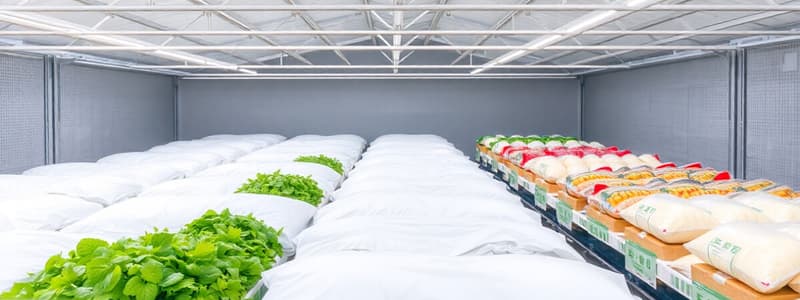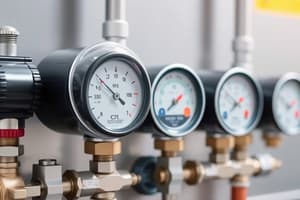Podcast
Questions and Answers
Which process in the refrigeration cycle allows the refrigerant to absorb heat from the air inside the refrigerated room?
Which process in the refrigeration cycle allows the refrigerant to absorb heat from the air inside the refrigerated room?
- Compression
- Condensation
- Evaporation (correct)
- Expansion
What is the primary role of the condenser in the refrigeration cycle?
What is the primary role of the condenser in the refrigeration cycle?
- To control the flow of refrigerant
- To expand the refrigerant
- To absorb heat from the refrigerant
- To release heat from the refrigerant (correct)
Which component is responsible for controlling the operation of the refrigeration system?
Which component is responsible for controlling the operation of the refrigeration system?
- Manual Disconnect Switch
- Thermostat (correct)
- Expansion Valve
- Pressure Switch
What happens during the expansion phase of the refrigeration cycle?
What happens during the expansion phase of the refrigeration cycle?
What type of switch provides added protection in refrigeration systems aside from the built-in overload control?
What type of switch provides added protection in refrigeration systems aside from the built-in overload control?
What is the heat lost when a refrigerator door is opened primarily attributed to?
What is the heat lost when a refrigerator door is opened primarily attributed to?
Which component controls the flow of refrigerant in the refrigeration cycle?
Which component controls the flow of refrigerant in the refrigeration cycle?
During the compression phase of the refrigeration cycle, what is the refrigerant primarily doing?
During the compression phase of the refrigeration cycle, what is the refrigerant primarily doing?
How many BTU must be removed to lower the temperature of 200 lb of beef from 90°F to 40°F?
How many BTU must be removed to lower the temperature of 200 lb of beef from 90°F to 40°F?
What is the specific heat of beef when above freezing point?
What is the specific heat of beef when above freezing point?
Which refrigeration system rating applies to a zero-degree room?
Which refrigeration system rating applies to a zero-degree room?
What is the latent heat of fusion for cabbage?
What is the latent heat of fusion for cabbage?
If a chill room has a volume of 350 ft³ and requires BTU removal of 6.5 BTU/ft²-hr, what is the total heat to be removed per hour?
If a chill room has a volume of 350 ft³ and requires BTU removal of 6.5 BTU/ft²-hr, what is the total heat to be removed per hour?
What is the specific heat of milk above freezing point?
What is the specific heat of milk above freezing point?
What is the temperature range typically used for butter storage?
What is the temperature range typically used for butter storage?
The heat to be removed for a refrigeration unit can be determined by adding what two components?
The heat to be removed for a refrigeration unit can be determined by adding what two components?
What is the total cooling load in BTU/hr for the products being cooled?
What is the total cooling load in BTU/hr for the products being cooled?
Which type of air conditioning system has the highest recommended room area when insulated?
Which type of air conditioning system has the highest recommended room area when insulated?
What is the required individual circuit provision for air conditioning installations intended for safety?
What is the required individual circuit provision for air conditioning installations intended for safety?
How much BTU/hr does cooling 100 lbs of cabbage from 85 to 35 F require?
How much BTU/hr does cooling 100 lbs of cabbage from 85 to 35 F require?
What cooling load in BTU/hr is calculated for cooling 200 lbs of fresh beef from 85 to 35 F?
What cooling load in BTU/hr is calculated for cooling 200 lbs of fresh beef from 85 to 35 F?
What would be the estimated space load for a room with an area of 292 ft²?
What would be the estimated space load for a room with an area of 292 ft²?
What should be included to ensure safe operation of an air conditioning unit?
What should be included to ensure safe operation of an air conditioning unit?
What is the primary purpose of refrigeration in agriculture?
What is the primary purpose of refrigeration in agriculture?
Which of the following refrigerants is known for being highly toxic and flammable?
Which of the following refrigerants is known for being highly toxic and flammable?
What process is responsible for the cooling effect in refrigeration?
What process is responsible for the cooling effect in refrigeration?
Which refrigerant listed is considered nontoxic and nonflammable?
Which refrigerant listed is considered nontoxic and nonflammable?
What effect does condensation have on gaseous refrigerants?
What effect does condensation have on gaseous refrigerants?
Which refrigerant is known for requiring high operating pressure?
Which refrigerant is known for requiring high operating pressure?
What is a critical role of refrigerants within refrigeration systems?
What is a critical role of refrigerants within refrigeration systems?
Which application does NOT fall under the use of refrigeration in agriculture?
Which application does NOT fall under the use of refrigeration in agriculture?
Flashcards
Refrigeration Cycle
Refrigeration Cycle
The complete series of events in a refrigeration system as refrigerant travels.
Condensation (Refrigeration)
Condensation (Refrigeration)
High-pressure, high-temperature gas releases heat to the surroundings.
Expansion Valve
Expansion Valve
High-pressure liquid refrigerant escapes and expands.
Evaporation (Refrigeration)
Evaporation (Refrigeration)
Signup and view all the flashcards
Compression (Refrigeration)
Compression (Refrigeration)
Signup and view all the flashcards
Heat to remove for cooling products
Heat to remove for cooling products
Signup and view all the flashcards
Heat loss from environment
Heat loss from environment
Signup and view all the flashcards
Electrical Control (Refrigeration)
Electrical Control (Refrigeration)
Signup and view all the flashcards
Refrigeration
Refrigeration
Signup and view all the flashcards
Refrigerant
Refrigerant
Signup and view all the flashcards
Ammonia
Ammonia
Signup and view all the flashcards
Freon
Freon
Signup and view all the flashcards
Refrigeration Principles
Refrigeration Principles
Signup and view all the flashcards
Evaporator
Evaporator
Signup and view all the flashcards
BTU/lb-F
BTU/lb-F
Signup and view all the flashcards
Specific Heat (Beef)
Specific Heat (Beef)
Signup and view all the flashcards
Product Load
Product Load
Signup and view all the flashcards
Space Load
Space Load
Signup and view all the flashcards
Refrigeration Size (Tons)
Refrigeration Size (Tons)
Signup and view all the flashcards
Refrigeration Capacity (BTU/hr)
Refrigeration Capacity (BTU/hr)
Signup and view all the flashcards
Chill Room Insulation
Chill Room Insulation
Signup and view all the flashcards
Zero-Degree Room Insulation
Zero-Degree Room Insulation
Signup and view all the flashcards
BTU/hr
BTU/hr
Signup and view all the flashcards
Cooling Load Calculation
Cooling Load Calculation
Signup and view all the flashcards
Air Conditioner Types
Air Conditioner Types
Signup and view all the flashcards
Air Conditioner Size Selection
Air Conditioner Size Selection
Signup and view all the flashcards
Air Conditioner Electrical Safety
Air Conditioner Electrical Safety
Signup and view all the flashcards
Cooling System Components
Cooling System Components
Signup and view all the flashcards
Room Area and HP
Room Area and HP
Signup and view all the flashcards
Rule of Thumb for Air Conditioning
Rule of Thumb for Air Conditioning
Signup and view all the flashcards
Study Notes
Electricity for Cooling
- Presented by Engr. Alexis T. Belonio, Department of Agricultural Engineering and Environmental Management, College of Agriculture, Central Philippine University, Iloilo City.
- Contact: [email protected]
Application of Refrigeration and Cold Storage of Crops
- Preserves and stores farm produce like eggs, milk, meat, vegetables, fruits, and flowers.
- Extends the storage time of grain seeds.
- Maintains the freshness of newly caught fish before processing.
Refrigeration Equipment
- Various types of refrigerators and chillers are shown.
Farm Structures and Offices
- Properly ventilating farm structures (like poultry houses, dairy farms, crop conditioning facilities) improves the environment inside.
- Better ventilation leads to improved conditions in farm houses and offices.
Principles of Refrigeration
- Refrigeration works by removing heat to lower the temperature of a substance or space.
- Refrigeration systems take heat from an enclosed space and release it outside.
Refrigerant
- A refrigerant is a substance that absorbs heat from a refrigerated space and releases it outside.
- Common refrigerants include:
- Ammonia (oldest and widely used for large installations)
- Methyl chloride
- Sulfur dioxide
- Freons (commonly used today).
Properties of Refrigerants
- Properties of various refrigerants are listed in a table, including refrigerating effect (BTU/lb) per standard cycle and remarks.
Evaporation
- Evaporation changes liquid refrigerant to gas.
- Adding heat to the refrigerant causes evaporation.
- Evaporation of refrigerant lowers the temperature of the surrounding area.
- The evaporator is located inside the refrigerated space to absorb heat.
Condensation
- Condensation transforms gaseous refrigerant back into liquid.
- Heat must be removed from the refrigerant to condense it.
- The cooler space removes heat from the refrigerant, causing condensation.
- Condensers are positioned outside refrigerated spaces to release the absorbed heat.
Refrigeration Cycle
- The complete series of events as the refrigerant flows through the system.
- Includes specific parts like condenser, compressor, expansion valve, and evaporator.
Refrigeration Cycle Details
- The refrigeration cycle consists of four key steps:
- Expansion: High-pressure liquid refrigerant flows through a valve to a low-pressure pipe, expanding and lowering its temperature.
- Evaporation: The now lower-temperature liquid refrigerant absorbs heat from the refrigerated space, changing to a gas.
- Compression: The gaseous refrigerant is compressed by a compressor, increasing its temperature and pressure.
- Condensation: The hot, high-pressure gaseous refrigerant releases heat to the outside environment, changing back into a liquid.
Electrical Control for Refrigeration
- Various components control a refrigeration system.
- Components include:
- Manual disconnect switch for maintenance/safety
- Time delay fuses for additional protection
- Thermostat to control operation.
- Solenoid valve for refrigerant flow control.
- Pressure switch (low/high pressure).
Quantities in Refrigeration
- Heat required to cool the product, lowering temperature.
- Heat removed to cool the refrigerated space, focusing on heat transfer from outside elements.
Heat Removed from the Product
-
Calculating heat removal for cooling products.
- Formula: Q product = specific heat x mass of product x temperature difference
-
Example: Calculating BTU required to cool 200 lbs of fresh beef from 90F to 40F.
Specific Heat of Farm Products
- Table showing the specific heat of various farm products.
Heat to Remove for Cooling the Space
- Calculating the heat loss from the surrounding environment.
- Calculating for specific sizes of refrigerated spaces using insulation types.
Rating of Refrigerating System and Rule of Thumb
- Finding the total heat removal required (product and space loads.)
- Formula for Tons of refrigeration: Divide the total heat removal in BTU/hr by 12,000.
- Rule of thumb: The horsepower of a refrigerator system relates directly to the tons of refrigeration. - 1 horsepower = 1 ton of refrigeration (chill rooms) - 2 horsepower = 1 ton of refrigeration (zero-degree rooms)
Sample Calculations
- Sample calculation for walk-in cooler dimensions and products.
Room Air Conditioning
- Types of room air conditioners (console, built-in, and window).
- General size selection recommendations.
- Electrical considerations (individual equipment branch circuit).
Components of Air Conditioner Systems
- Illustrations of condenser, evaporator, and compressor are shown.
Central Air-Conditioning and Heating System
- Diagrams of a central air-conditioning and heating system.
Selection Data for Air Conditioners (HP-Size of Air Conditioners)
- Charts guide proper size selection of air conditioners considering factors like room area, insulation, nighttime operation.
Rule of Thumb for Air Conditioning Design
- A rule of thumb for air conditioning system sizing: 20 square meters of floor space with an 8-foot height at 27°C requires a 1-horsepower air conditioning system.
References
- A list of sources for information about refrigeration.
Studying That Suits You
Use AI to generate personalized quizzes and flashcards to suit your learning preferences.




